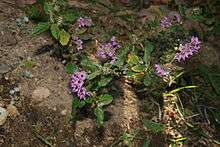Thomasia purpurea
| Thomasia purpurea | |
|---|---|
 | |
| Scientific classification | |
| Kingdom: | Plantae |
| (unranked): | Angiosperms |
| (unranked): | Eudicots |
| (unranked): | Rosids |
| Order: | Malvales |
| Family: | Malvaceae |
| Genus: | Thomasia |
| Species: | T. purpurea |
| Binomial name | |
| Thomasia purpurea (W.T.Aiton) J.Gay[1] | |
| Synonyms | |
|
Lasiopetalum purpureum Dryand. | |
Thomasia purpurea is a small shrub that is endemic to the southwest of Western Australia.[2] It usually grows to between 0.3 and 1.2 metres in height.[2] Pink to purple flowers are produced between April and December in the species native range.[2]
The species was first formally described by Swedish botanist Jonas Carlsson Dryander, his description published in William Aiton's Hortus Kewensis in 1811 as Lasiopetalum purpureum.[3] The type specimen was collected by botanist Robert Brown from King George Sound in 1801. In 1821 French botanist Jacques Etienne Gay placed the species in the genus Thomasia.[1]
References
- 1 2 "Thomasia purpurea". Australian Plant Name Index (APNI), IBIS database. Centre for Plant Biodiversity Research, Australian Government, Canberra. Retrieved 12 December 2011.
- 1 2 3 "Thomasia purpurea". FloraBase. Western Australian Government Department of Parks and Wildlife.
- ↑ "Lasiopetalum purpureum". Australian Plant Name Index (APNI), IBIS database. Centre for Plant Biodiversity Research, Australian Government, Canberra. Retrieved 12 December 2011.
This article is issued from Wikipedia - version of the 12/12/2011. The text is available under the Creative Commons Attribution/Share Alike but additional terms may apply for the media files.